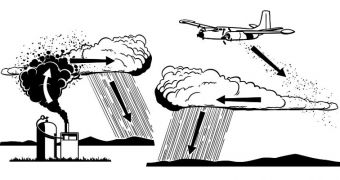Cloud seeding is a means of controlling precipitations over a certain area. Basically, it refers to using various types of particles to elicit the formation of water droplets above areas that would otherwise suffer from drought. Generally, seeding clouds is very difficult, and can be achieved via two methods – ground-level particle generation and the airborne approach, which uses rockets or airplanes for the job. But a new investigation suggests that jetliners and turboprops can create clouds as well, albeit unintentional, OurAmazingPlanet reports.
This usually takes place when the airplanes take off or land through mid-level clouds, under specific atmospheric conditions. They can leave rain or snow in their wake as they move along, researchers say, in essence acting like “seeders.” This happens primarily on account of the fact that the passing of the airplanes generate holes in the clouds, of various shapes and sizes. The snow and rain that is generated when this happens falls to the ground in narrow strips, and does not constitute an important quantity of the overall precipitations falling above an area.
“Any time aircraft fly through these specific conditions, they are altering the clouds in a way that can result in enhanced precipitation nearby,” explains Andrew Heymsfield, an expert at the Boulder, Colorado-based National Center for Atmospheric Research (NCAR). He was also a coauthor on the new investigation, which will be detailed in the upcoming June edition of the esteemed journal Bulletin of the American Meteorological Society. He adds that experts have known about this phenomenon for many years, but that the mechanisms behind it have largely remained a mystery until now.
Heymsfield says that the airplanes literally seed clouds simply by flying through them. The reason why this happens is because clouds contain water droplets that are cooled at very low temperature – about minus 15 degrees Celsius, or minus 5 degrees Fahrenheit. Despite their temperatures, the droplets are still liquid, but that changes when the wings set them into motion. They begin to condense, and eventually fall to the ground as precipitation. “You wouldn’t necessarily see it from satellite or from the ground. I had no idea this was happening. I was sitting in back of the plane. And then this data set just fell in our laps. It was a lucky break,” Heymsfield concludes.

 14 DAY TRIAL //
14 DAY TRIAL //